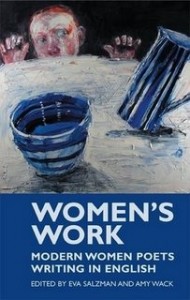Women's Work: The Poetic Justice Forum
BY Annie Finch

My poetry trip to the U.K. this winter was marked, among many wonderful experiences, by something more sobering: a string of stories poured out to me by women poets about gender imbalance and discrimination in prizes and book and journal publishing at the top levels of the British poetry world. While I am a natural idealist and would prefer to spend most of my time sitting under a pine tree writing and reading, sometimes a situation cries out inescapably for action. Starker than similar accounts I’ve heard in the U.S., yet all too familiar, these tales inspired me to address my longstanding frustraion at the stagnation in po-biz. As Eva Salzman points out in the introduction to her cross-Atlantic poetry anthology Women’s Work: Modern Women Poets Writing in English, it is still true that “the baggage attached to ‘woman poet’—poetess or not—is more like a lead weight.”
Salzman’s introduction cites legions of statistics from the tables of contents of recent anthologies (“ 101 Oxford Book of Contemporary Verse: 3 women/37 men, Sonnets ed. Don Paterson: 13 women/87 men,” and a couple dozen more), as well as quotes from recent reviews and books of criticism proving thoroughly her point that it still holds true that, to quote James Fenton on Plath: “like it or not, there was something masculine in the archetype of poet, with which it was difficult for a woman to come to terms.” (in an amusing imaginative exercise, Salzman puts herself in the place of a male poet feeling belittled by being included in an anthology of male poets, and visualizes “the long-awaited publication of Men Poets of the Twentieth Century).
Salzman points out that even with “the fairer acknowledgment” of the most enlightened and most recent anthologies, nevertheless almost all of them “hit the proverbial glass ceiling, with women poets comprising roughly a third of the total.” I was reminded of this statistic when I read in the paper the other morning about a commencement address given by Geena Davis at a college in Maine last week. Speaking on the topic of gender and film, Davis pointed out that on kids' TV shows, the gender representation is now holding steady at 3 male characters for every 1 female character. That ratio will be familiar to anyone who has the habit of counting names in tables of contents of prestigious literary journals and anthologies (see the Harriet discussion on Numbers Trouble)—and I recall they also match up with the amount of time that men on average report that women can participate in a conversation before it feels like they are "talking too much," according to Deborah Tannen’s book You Just Don't Understand: Men and Women in Conversation.
My own concern with these ratios is not so much with the proportions themselves—after all, men have the momentum of having published poetry for centuries longer than women, and to focus on the numerical difference between a third and a half, however frustrating and annoying that situation on a personal level, might seem akin to hollow bean-counting—but with what these numbers imply about the prevailing climate of poetics. And that prevailing climate affects not a third, but a hundred, percent of the poetry world. The fact that the ratio holds women so firmly a safe distance below the one-half mark and refuses to budge, in spite of the astronomical increase in the numbers of women (more than half the population to begin with) who are writing and publishing poetry today, implies that something more than mere numbers is at stake. I believe that what is at stake is the very existence of a context in which it is possible to explore the full possibility of alternative poetic voices. (Of course, all kinds of diverse poetic voices are eventually implicated in this discussion, but a long-growing body of sociological and psychological theory shows women as the primordial “other” and even now, as Salzman reminds us, “statistics [in a New York Times survey on hiring] showed that, consistently, people can overlook race more readily than gender.”)
There may not be such a thing as “women’s poetry.” But, as long as women’s voices are capped at a third of poetic discourse, we will never really know if there is or not. The overall climate of criticism, canon-formation, publication, and recognition is defined by the majority poetic. As Germaine Greer puts it, “the blokes like the girls best when they write like the blokes, and extra-specially when they write about girls the way the blokes do. It suits the male poet to believe that neither sex I specifically intended because it encourages him I his view that his specificity is actually universality. The woman poet who knowingly places this game is not so much a ventriloquist as a ventriloquist’s dummy.” Until we have the courage to create space for a fluid dynamic of parity between women’s and men’s voices in the general consciousness and in the poetry world specifically, we will all of us—women and men poets alike—be to some extent ventriloquist’s dummies.
To create a space where conversation about these issues can flourish across the English-writing world, U.K. poet Jane Holland and I have collaborated in creating the Poetic Justice discussion forum. An accompanying Poetic Justice website with further information and links to resources will be mounted soon. (If you know of articles, websites, blog discussions, and other information and resources that should be linked to Poetic Justice, please let me know here or by email to my website.). Here’s the link to the Poetic Justice forum:
To join the Poetic Justice Discussion, please log on at http://z3.invisionfree.com/Poetic_Justice/index.php?act=idx
Annie Finch is a poet, translator, cultural critic, and performance artist. She is the author of seven…
Read Full Biography

